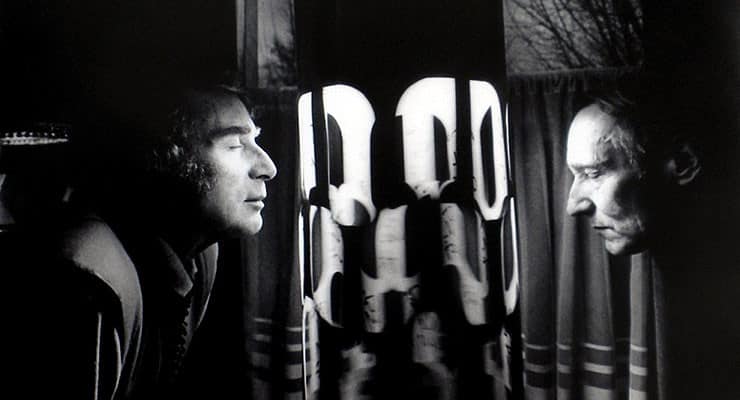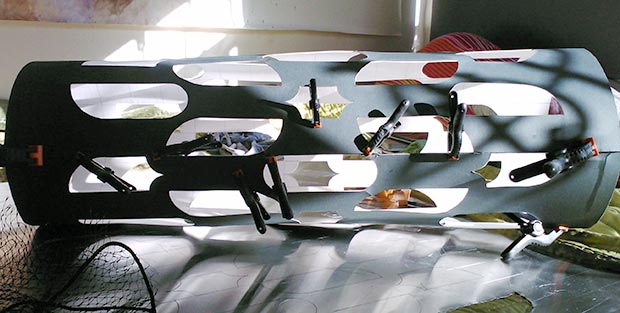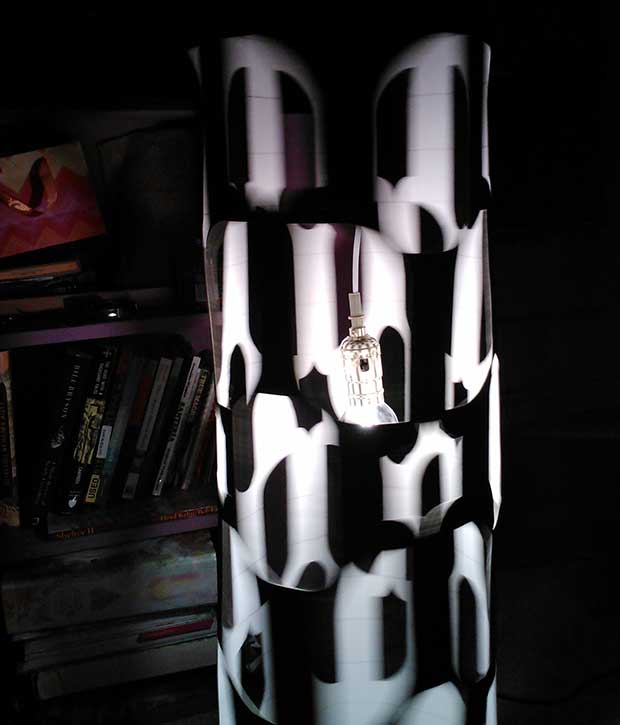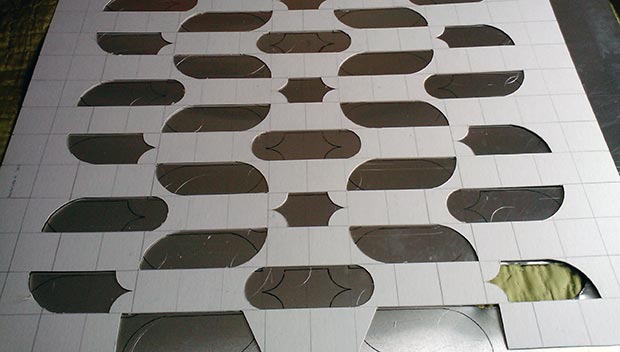
Build a Dream Machine, Brion Gysin and William Burroughs’ Device for Sober Hallucinations, for about fifty dollars
The Dream Machine is a device for altering the brainwave frequency of the user and putting it into an alpha state, at which point it begins generating waking, sober hallucinations and internal “movies,” on demand.
The machine is simple: it’s a rotating cylinder with slats in the sides and a light placed inside, that creates a flicker pattern as it spins. The user of the Dream Machine sits in front of it with eyes closed, and allows the precisely-calibrated flicker pattern to play over their face, creating a strobe effect in the darkness behind their eyelids. After a short period of adjustment, the user begins to experience eidetic imagery, in the same way that one does just as passing over the threshold between wakefulness and sleep. (Due to its cylindrical nature and ability to generate internal movies, one might call it the original YouTube.)
Outer Gateways
This remarkable and overlooked object was invented in the late 1950s by artistic Renaissance man Brion Gysin and the electronics technician Ian Sommerville. Gysin was expelled from the Surrealist Group by André Breton at the age of 19; with the Dream Machine, he surpassed their previous techniques for image generation. (An example of a prior method is Salvador Dalí’s Paranoiac-Critical exercise, in which the artist would fall asleep in an armchair while holding a rock in his hand and, upon his fingers relaxing and the rock crashing to the ground and waking him, would immediately record what he had just seen.) The Dream Machine allowed for a convenient and immediate way to get at eidetic imagery without having to go to sleep or take chemicals.
Gysin had been inspired by both childhood and adult experiences with the effects of flicker, by historical accounts of its use (Nostradamus was alleged to have received his visions by closing his eyes, facing towards the sun and flickering his fingers in front of his eyes) as well as by research into medical reports of its effects. At the infamous Beat Hotel in Paris where he lived with Sommerville and Burroughs (along with Allen Ginsberg, Peter Orlovsky, Gregory Corso, the vicious crime writer Derek Raymond and others) he constructed the first prototype. It quickly became a source of fascination for the Beats.
Smash the Control Images — Smash the Control Machine
Burroughs wrote about Dream Machines extensively in his novels, where he depicted them as a weapon for the freedom of consciousness in the eternal war against Control. The author spoke highly of his friends’ invention, saying: “Subjects report dazzling lights of unearthly brilliance and color… Elaborate geometric constructions of incredible intricacy build up from multidimensional mosaic into living fireballs like the mandalas of Eastern mysticism or resolve momentarily into apparently individual images and powerfully dramatic scenes like brightly colored dreams.”
The machine was officially unveiled in 1962, at the Louvre’s Museé des Arts Decoratifs, to a fascinated public and press—but Gysin, unsatisfied with a small art audience, dreamed of mass production. Along with the cut-up method of text composition he had honed with Burroughs, Gysin considered the Dream Machine his magical message to the world.
He turned first to business magnate Helena Rubinstein, who was taken with the device and exhibited it in her shop windows, but then refused to pay for it. Next Gysin tried the Philips Corporation—a representative of the company, while visiting Gysin at the Beat Hotel, slipped on dogshit in the hall; the deal was cancelled. Later, Colombia Records wanted to market the Dream Machine as a lamp. Meeting with Colombia executives in 1965, Gysin (ever the magician) told them that vinyl records would soon be obsolete, replaced with optical discs that were read with a ray of light. He was not well received.
Communication must become total and conscious before we can stop it…
Gysin died in 1986, the cause of the Dream Machine having been taken up by his protégé Genesis P-Orridge and the loose occult and media subversion network the Temple ov Psychick Youth. TOPY both propagandized the Dream Machine and distributed information on how to make your own, using Gysin’s original plans.
Since the 90s, the Dream Machine has become a kind of elitist status symbol, often found in the possession of West Coast media types and young celebrities. Kurt Cobain bought one shortly before his death. David Bowie, Iggy Pop and Paul McCartney all used it. Other aficionados include Marilyn Manson, Floria Sigismondi, Bruce Labruce, Nick Zinner of the Yeah Yeah Yeahs, Beck and DJ Spooky.
Creating your own is not hard: All one needs is a large sheet of cardboard, an X-Acto blade to cut the slats out, a light bulb on a cord and a spare turntable. Check out our instructions for doing so below!
How to Build Your Own Dream Machine (Instructions and Photos by Ultraculture Contributor Hildemar Cruz!)
It’s hard for me to pinpoint the exact resource that lead me to discover the Dream Machine. Was it music, the words of Burroughs or magical experimentation? Regardless of the source, once I saw the price of some prefabricated models (roughly $450) I decided to try creating my own “innerverse” machine. I spent, altogether, about $50-60 in materials to create my own. Although I ran into some obstacles while putting my Dream Machine together, once you get all the materials, assembly can be completed within a day.
(Here’s a Google Docs link to the original plans for the Dream Machine published by Thee Temple of Psychick Youth, now out of print.)
Materials needed:
• 32” x 32” (minimum) aluminum sheet or heavy cardboard, depending on how classy you want the Dream Machine to look.
– You can find the heavy board at any art supply store. You can cut out the pattern using any ol’ blade or a Xacto knife.
– You can buy the aluminum sheet at your local hardware store. Just make sure you have the proper instruments to cut the shapes out of the aluminum and avoid warping the sheet.
• 78 r.p.m. turntable
– Can be found at thrift stores or second hand stores; however you must be willing to hunt for one. eBay is another good source. You can find them relatively cheap, but expect to pay a hefty shipping fee. Oh—and make sure it can actually turn 78s, not just 33s or 45s.
• Light bulb, socket and power cord
– You can either take the light bulb and socket out of an old lamp, find an old lamp at a thrift store, or you can buy a lamp making kit at your local hardware store for about $10 and some change.
• Tools:
– Xacto Knife or blade
– Super glue or another strong adhesive (I use Zap-A-Gap with an accelerator like Insta-Set)
– Pencil
– Ruler
– Sand paper
– Clamps
Step 1: Prepare the record player. Remove any hood, arms or other elements that will serve no purpose for the Dream Machine. Remember, all you need is the spinning table. Everything else will just get in your way.
If curiosity leads you to look under the hood of the record, so to speak, feel free to explore but be careful not to damage any of its parts, otherwise the turn table will not spin for you.

Step 2: Take your sheet of aluminum and create a grid. Each line should be two inches apart, going in both directions, creating two inch squares.
Now you can either print & cut out the templates included in the PDF instructions, or just draw them using the template as a guide. There are five different shapes. They are all a slight variations of each other set to a distinct pattern. If you want to see a full size version of each, refer to the plans or the template.
Personally, I stumbled upon some obstacles while attempting to create the hood using the aluminum sheet. I just didn’t have the right tools to cut the shapes out without distorting the metal. So I switched over to the heavy cardboard sheet from my local art supply store and it worked out fine.
I like to sand the cuts afterwards just to make sure the shapes are even and aesthetically perfect, but that’s up to your own taste.
Step 3: After you’ve cut out the pattern, you must connect the each side of the hood. Be careful! You don’t want to tear the hood by handling it too roughly. If possible, carefully twist the cardboard so it takes the proper round bended shape. You may consider scoring the board so it maintains the shape, but your risk of ripping is higher.
This would be the ideal time to get an extra pair of hands to help you hold the hood in proper shape while you glue and clamp them into place. Let dry.

Step 4: If your turntable plate, like the one I bought, is not large enough to hold your hood, then you will have to create a base for it. I used a piece of the aluminum sheet that I discarded. Make it large enough that the hood can sit easily on top of it but not so large that you can’t get to the buttons on the face of the turn table.

Steps 5: Place your hood on top of the turntable and set the rotation speed to 78 r.p.m.

Step 6: Suspend the lamp about 1/3 but no further than halfway into the hood of the dream machine. I just hung mine from a light fixture on the roof of my room. You may need to get an extension cord.

Step 7: Turn off all the lights and make sure you sit very close to the rotating Dream Machine while you begin your meditation. Keep your eyes closed throughout the meditation.

[…] LIES: Comment construire une machine de rêve, votre portail de Inner Visions […]